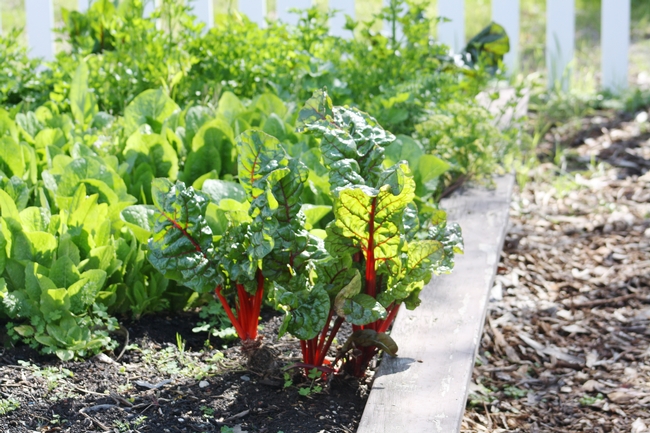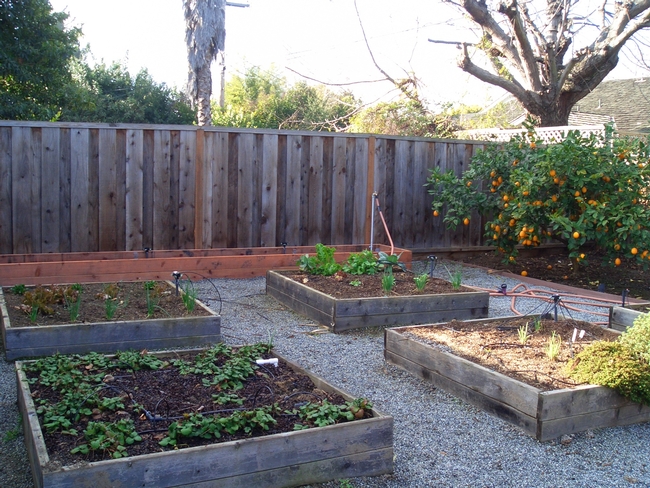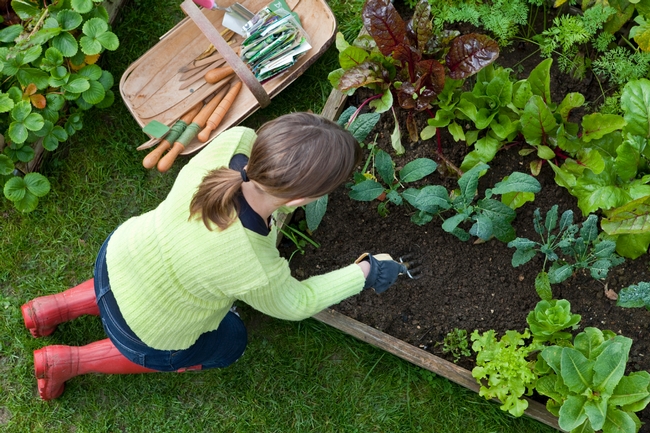Posts Tagged: Vegetables
Ten tips for vegetable gardening during a drought
Is it possible to grow a vegetable garden when water resources are scarce and water rationing could be imposed? Water responsibly, plant carefully, and select fruit and vegetable varieties that are drought tolerant. All of these sustainable gardening practices require less water – and help ensure your family has access to a variety of nutrient rich foods.
Ten simple drought tips to reduce water use in your backyard garden
- Planting time
Plant earlier in spring and later in fall. Planting earlier in the spring season takes advantage of the warm weather and reduces exposure to high mid-summer temperatures. Planting later in the fall minimizes the use of supplemental water and takes advantage of seasonal rains to establish plants. For example, tomatoes and other nightshade crops such as peppers and eggplants, should not be planted until soil temperatures reach 55 degrees. With a warm spring this could be as early as mid-April. Remember to always use a soil thermometer for accurate soil temperature readings.
- Mulch, mulch, mulch!
A 3- to 4-inch layer of mulch can reduce watering needs by as much as 50 percent. Mulch reduces water evaporation and keeps soil temperatures down during hot summer months. Grass clippings, dried leaves, pine needles, straw and shredded bark are all examples of natural mulches which can be used to cover the soil. Hay is not recommended because it contains seeds, which yields weeds and can become a problematic option.
- Enclosed spaces
Gardens planted in enclosed spaces, for example a raised garden bed, retain water better than gardens planted in open soil. Plant seeds and transplants in a hexagonal "off-set" pattern rather than in straight rows. A hexagonal arrangement groups plants closer together, which provides shade from leaves, keeping soil cool and water from evaporating. - Companion planting
Companion planting is the practice of grouping crops together for mutual benefit. The Native American “three sisters” approach of planting corn, beans and squash together are the perfect example of companion planting. Tall cornstalks provide a structural support for the climbing beans, the beans return nitrogen back into the soil, and the squash spreads across the soil acting as a mulch and keeping the soil cool. - Watering times
The best time to water your garden is in the late evening and early morning hours, typically between 9 p.m. and 6 a.m. The cooler morning temperature and limited wind reduced water evaporation rates. - Water efficiently
Overhead watering with a sprinkler system is not as efficient as drip irrigation. Compared to overhead sprinklers - drip systems can reduce water usage by up to half. Install a drip irrigation system, grouping plants with similar water needs together on one drip irrigation line. Drip irrigation systems are relatively easy to install for most do-it-yourself homeowners. The UC Division of Agriculture and Natural Resources book Drip Irrigation in the Home Landscape is a great reference on the materials, design and installation of a drip system.
- Control Weeds!
Pesky weeds compete for valuable water, sunshine and soil nutrients in your garden. Remove weeds before they have an opportunity to flower or spread. Visit the UC Integrated Pest Management website for tips on controlling weeds to identify recommendations for specific weed species. - Drought Resistant Crops
Purchase varieties of fruits and vegetable that do well in hot and dry climates. Many heirloom varieties from Mediterranean regions are prized for being drought tolerant. Smaller varieties bred for containers often produce a more bountiful yield per plant than standard varieties. Avoid water hogs! Some favorite water-efficient edibles from UCCE Master Gardeners include: asparagus, chard, eggplant, mustard greens, peppers, roma tomatoes, and California native strawberries. Check with a local UCCE Master Gardener Program about which varieties are recommended for your zone. - Peak water times
Fruit and vegetables have critical periods for increased water demands. For most plants once they become established watering times and amounts can be reduced until the flowering or fruit setting process begins. An increased amount of water should be reintroduced during this time. After this initial period of fruit set water can slowly be reduced again. In some cases, reducing water can improve the flavors of your harvest (think, dry-farmed tomatoes)! - Garden size
Determine the amount of fruits and vegetables needed to feed your family, does your family have two, four, or eight members? If you overproduced and wasted crops last year - decrease the amount of plants this year. Set up a garden exchange in your neighborhood so everyone grows less but still has a great variety!
The University of California Master Gardener Program extends to the public free UC research-based information about home horticulture and pest management. In exchange for the training and materials received from the University of California, Master Gardeners perform volunteer services in a myriad of venues. If you are interested in becoming a certified UC Master Gardener contact your local UC Cooperative Extension office.
Exotic Perennial Vegetables of the Month: Yacon and Malabar Spinach
When gardeners speak of “perennial vegetables,” the edible plants that often come to mind include asparagus, rhubarb, and artichoke. The purpose of this article is to introduce you to other rare and/or unusual perennial vegetables which may be worth cultivating in your own backyard garden.
My quest for rare and unusual perennial vegetables led me to a plant sale recently held at the Occidental Arts & Ecology Center in Occidental, California (see www.oaec.org for more information). Although I purchased a number of perennial vegetables at the sale, most of which I have no experience growing, this article will feature two of those plants, which seem to be thriving thus far in my Solano County backyard garden. I will report back on other weird and wonderful perennial vegetables in the coming months, depending on how well they fare.
I had been searching for yacon (Polymnia sonchifolia), also known as Bolivian Sunroot, for quite some time, and was thrilled to have found it at the OAEC plant sale. Yacon is considered one of the “Lost Crops of the Incas.” Yacon is a relative of the sunflower and and native to the high Andes. Although my yacon plant is currently 5 inches tall, the literature I have read indicates that my yacon plant should reach 5-feet tall at maturity. To harvest yacon, the tubers are dug up in the autumn (so I have another a year to wait). Yacon is a versatile plant, as it can be eaten raw like fruit, or can be stir-fried, roasted, baked or made into pies and chips. Some cultures use the leaves of the yacon plant with which to wrap their food. Although I have never tasted yacon as it is not readily available in the markets that I shop at, I have read that yacon tastes like jicama, only better. Another description that I found, said that yacon tastes like a cross between celery and a Granny Smith apple. Yacon is best grown in full sun and in well-drained, fertile soil.
In recent years, yacon has grown in popularity, both in gardening literature and in nurseries specializing in rare plants. This may be due to the fact that yacon is an up and coming “super food,” as food companies are developing yacon into various products such as yacon syrup, which is a low-calorie sugar substitute appealing to both diabetics and people on diets.
Although I debated whether to buy malabar spinach (Basella rubra) at the OAEC plant sale, I gave in, as I knew malabar spinach to be a staple for those interested in permaculture/creating an edible food forest in their backyards. It is not actually spinach, but has the flavor of spinach, and can be substituted in recipes which call for spinach (note that malabar spinach is fleshy and mucilaginous, and is best consumed cooked and not raw). Under the right conditions (e.g., full sun, and fertile, well-drained soil), malabar spinach which is a vine requiring trellising, can reach 8-10 feet in length. Because malabar spinach is so prolific, I have read that one vine is sufficient to feed a family of 4. Malabar spinach is frost tender and may need to be dug up and brought indoors during the winter.
I will report on other unusual perennials growing in my backyard in the coming months, so stay tuned for updates.
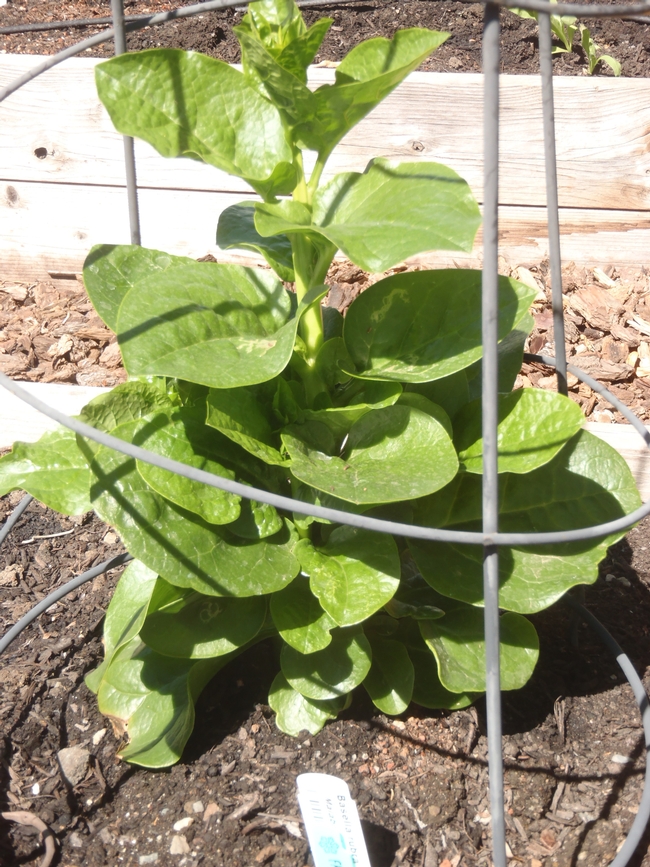
Malabar spinach. (photos by Betty Homer)
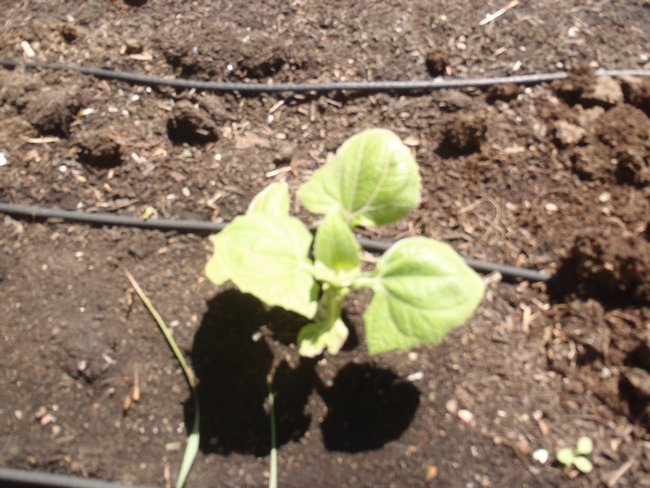
Yacon
Colorful and Tasty Neighborhood Bounty
I stroll pretty frequently through our neighborhood with dogs in tow. Many of my neighbors are gifted gardeners and I get a chance to check out and share in their summer bounty. While some of the "suburban farm plots" are shutting down for the season, others are still pumping out the tomatoes and squash. 'Bearss' Lime and 'Improved Meyer' lemon trees are bearing next to a driveway, volunteer squash are flowering by a hose spigot, baby lettuce is keeping company with Kranz aloe and bags of tasty tomatoes and squash appear at my front door along with peppers. Even okra grown from seeds brought in from Northern India is growing very well in the August sun.
Besides all this, one of my neighbors just brought over a dozen fresh eggs naturally colored in shades worthy of an Easter Egg Hunt. This hard working gardener has lots of that great by-product of chicken life she uses throughout her own salad bowl garden and orchard of fruit trees. And she lets a local beekeeper use a back corner for hives which produce lovely honey they both share.
Lots to see here when I put on my walking shoes and start looking around. It's a great way to stay in touch with my neighbors and share in their success as gardeners both literally and visually.
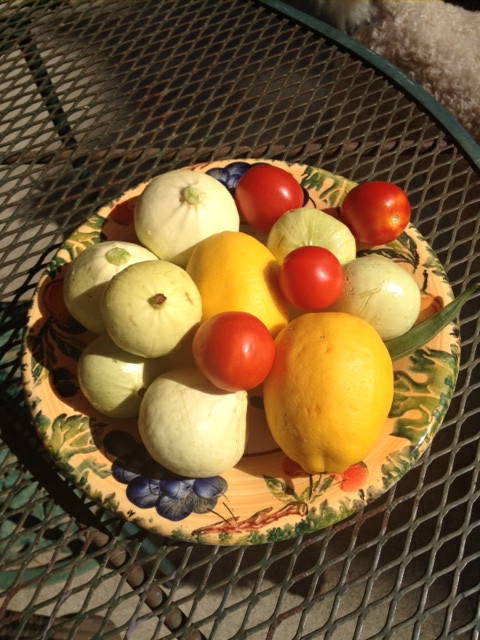
Shared bounty from neighbors. (photos by Trisha Rose)
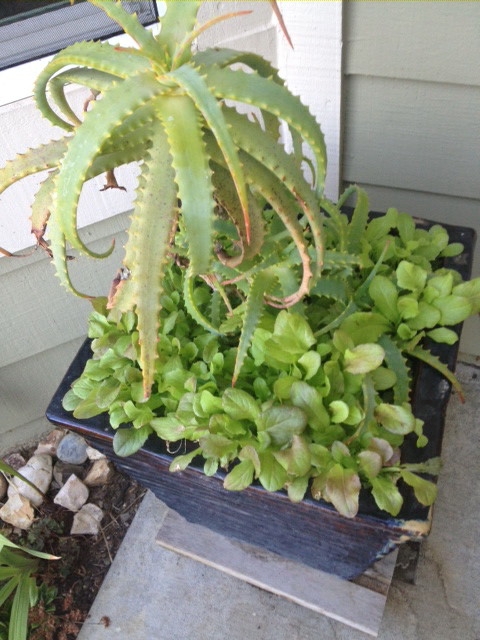
Aloe happliy growing with lettuce.
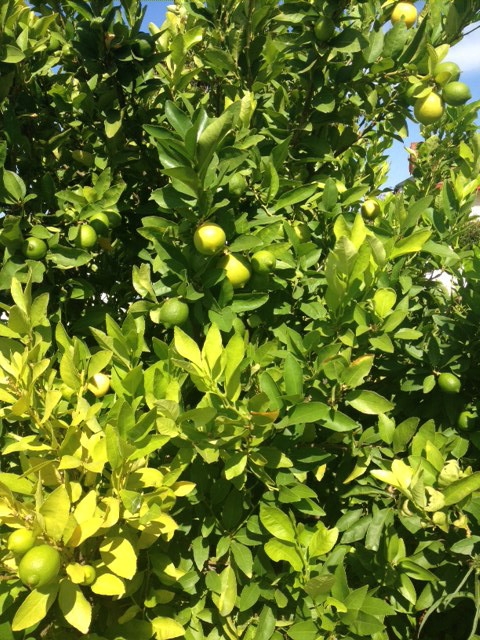
'Bearss' lime.
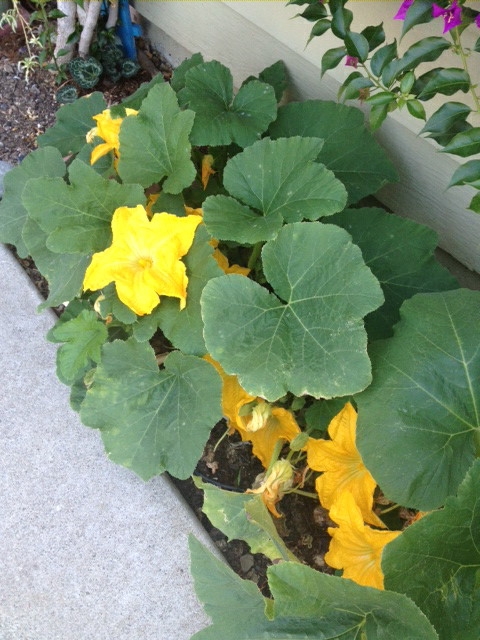
Volunteer squash in flower.
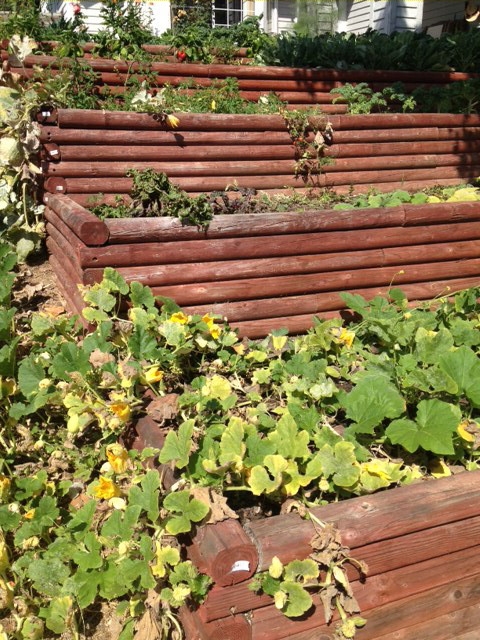
Planting beds, end of the season.
You're An Obsession, My Obsession
My current gardening obsession is hunting for nurseries and resources that carry perennial vegetables. Such plants are usually available in the U.S. during the Spring (they are currently available at this time of year in Australia), but being the impatient personality that I am, I am anxious to get going now.
But this post is not about perennial vegetables—that will come in a later post once I succeed in acquiring said unusual and rare plants (such vegetables will go well beyond asparagus and artichoke), which may occur sometime in August (if you are interested, see www.oaec.org). It was my pursuit of these perennial vegetable plants that led me to recently stumble across a wonderful bakery and a small edible garden tucked behind it, which is the subject of this post.
So you ask—where is this place where one can find both amazing food and a beautiful garden? The answer--in Freestone located in Sonoma County. The bakery is called “Wild Flour Bakery” and features tasty creations such as sticky bun bread, scones dotted with strawberry and white chocolate, and savory goods (see http://www.wildflourbread.com/). The garden behind the bakery is cleverly named “Wild Flower Gardens” (play on the word “Flower” and “Flour”) which I suspect supplies some of the fruit used in the bakery’s baked goods. Unlike many edible gardens that can become overgrown because there is so much to manage, Wild Flower Gardens is, on the whole, well-ordered. In that space, you will find a small grove of young fruit trees consisting mostly of pears and plums. Also, in that space, are edible plants (kale, lettuce, raspberries, grapes, herbs, etc.) combined with ornamentals, the arrangement of which always interests me, because I enjoy seeing how people integrate these seemingly disparate groups of plants so that they look harmonious together. Best of all, there is seating scattered throughout the garden where you are invited to bring your fresh baked goods in to sit down and enjoy. It is a great little weekend getaway, just slightly over an hour from Solano County--not to be missed!
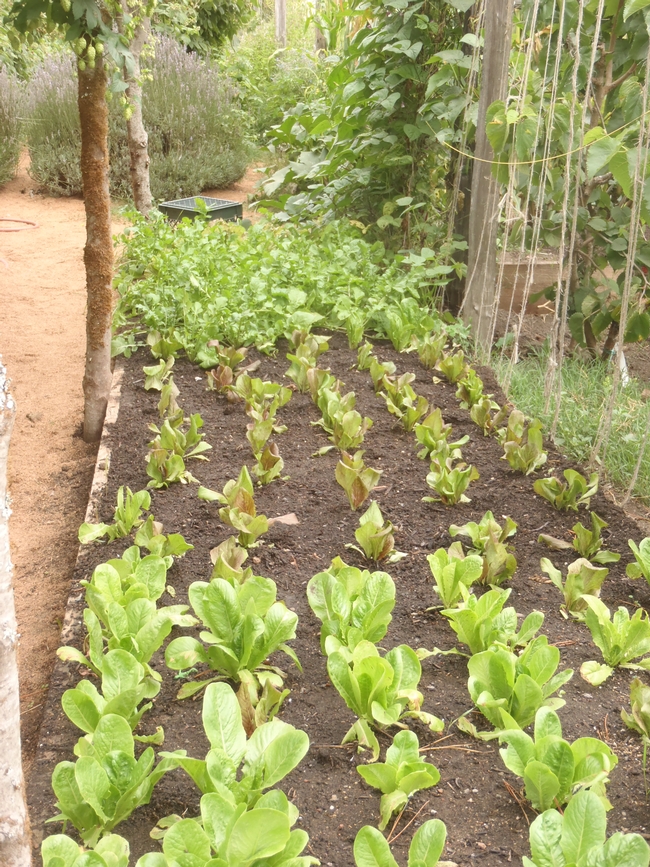
Rows of vegetables. (photos by Betty Homer)
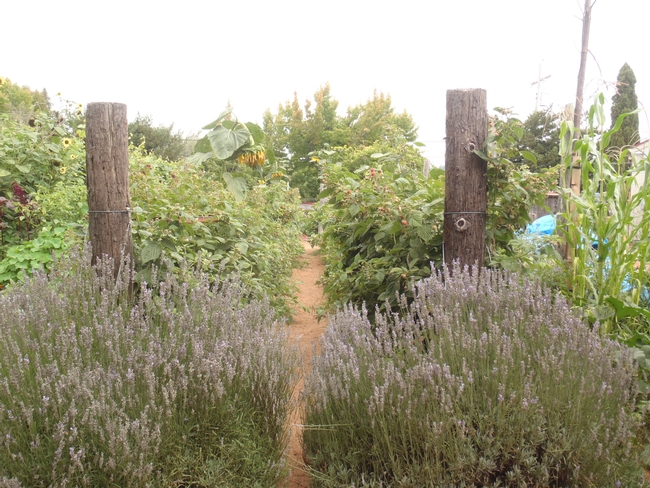
Lavendar and berries flank this pathway.
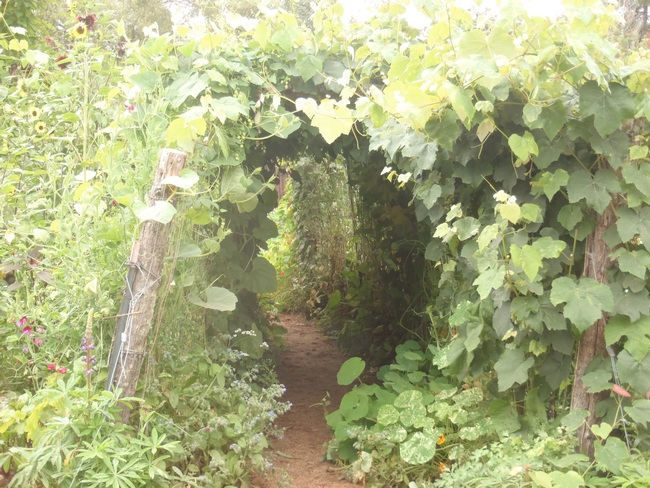
Grapevines above and nasturtiums below-enter at your own delight.
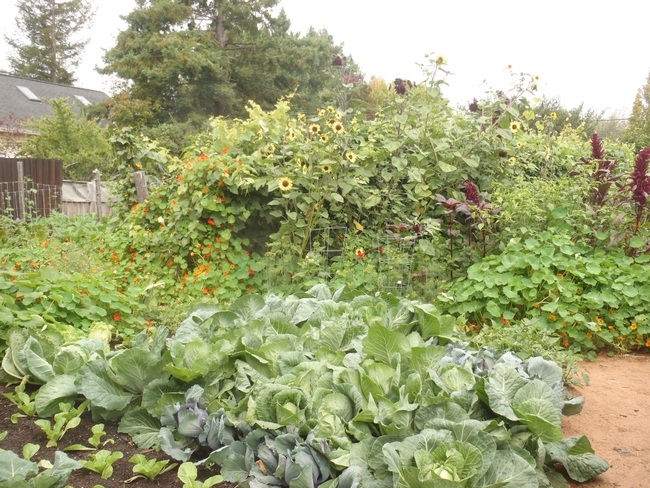
Sunflowers, and plumes of Amaranth in the background with cabbages in the fore.
Companion Planting
As the summer vegetable garden's bounty is harvested it is time to think about a second planting to keep things going and even begin to move towards cooler-season crops. According to Renee's Garden (gardening@reneesgarden.com) this is the perfect time to plant short season varieties. You can go to their website for planting information and even garden plans, but generally it is a good time to begin all the brassicas, lettuces and other salad greens, peas and several herbs. And it's a great time to think about companion planting.
A couple of months ago I was curious and did some research on companion planting and found that not only do some plants do better with certain others, but some are actually harmed (or at least hindered) by some others. I found, for instance, that you should never grow basil with sage. Oh. I had just planted a lovely couple of basil plants right next to my sage. And no herbs with the chard. Again, my little garden is a perfect example of what NOT to do. So here are a few things I learned and a couple of resources you might find interesting before you put in your next crops.
Do NOT plant any of the brassicas (cabbages, kale, kohlrabi, cauliflower) near tomatoes, beans, peppers, or strawberries. Likewise, do NOT plant potatoes near tomatoes or squashes; nor peas near onions, garlic, leeks or chives. Do plant your basil right next to your tomatoes. The basil actually improves the flavor of the tomatoes on the vine. Beets go well with lettuces, onions and the brassicas and are helped by catnip, garlic and mint.
If you find that your strawberries are being eaten by worms, try planting borage near them to strengthen their resistance to insects and disease. A border of thyme around those strawberries will also help deter the worms. Borage, in fact, along with loveage and geraniums, is a very good companion to almost everything including your cabbage.
Cilantro/coriander is good with spinach; sage will help repel moths from your cabbage crops and dill is a good companion to lettuce, cabbage and onions. But don't plant it near your tomatoes as it will attract the tomato hornworm.
Parsley sacrificially attracts insects that attack tomatoes. Tarragon's scent is disliked by most pests and is thought to have "nurse properties", enhancing the flavor of crops grown with it. Marigolds are a "wonder drug" in the garden, and FRENCH marigolds (Tagetes patula) produce from their roots a pesticidal chemical that will last in the soil years after the plants themselves are gone. Nasturtiums attract aphids so they will leave your other plants alone and the nasturtium petals and young leaves are great in a salad.
There is a wealth of information out there on companion planting and you can find information on just what you intend to plant. Below are some sources that I found helpful with one caveat: sometimes I found conflicting information in different sources. As always, gardening can be an adventure--but a beautiful and tasty one!
Resources
http://ucanr.edu (Search: Companion Planting)
http://www.organicgardening.com
wikipedia.org/wiki/List_of_companion_plants
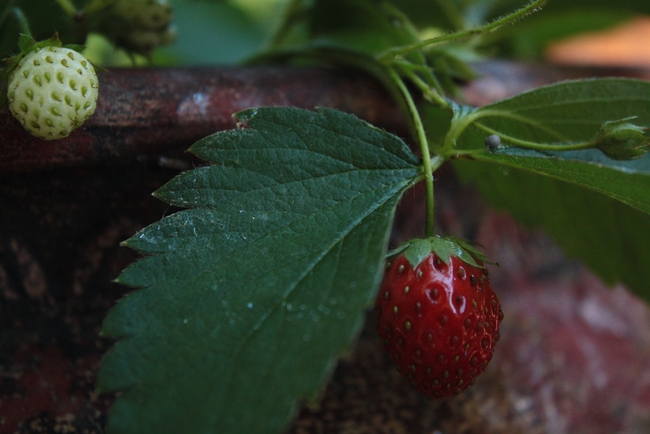
A strawberry dangles from a pot. (photos by Jennifer Baumbach)
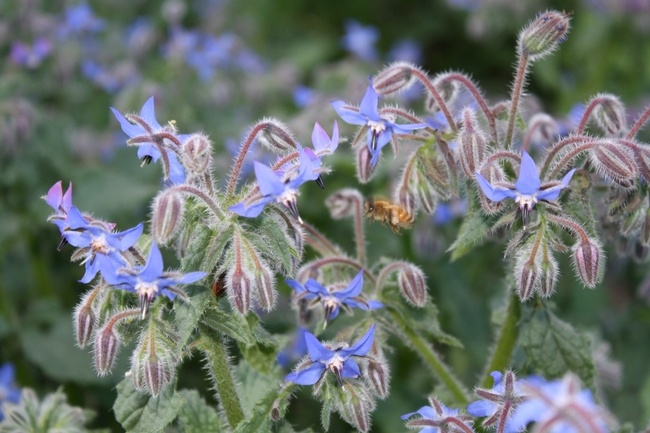
Bee visiting borage.


